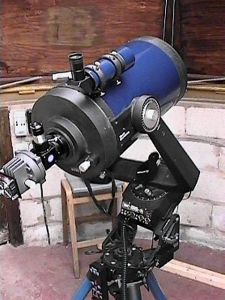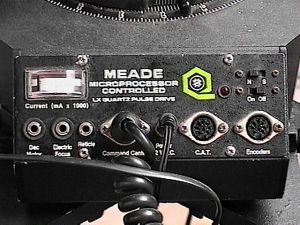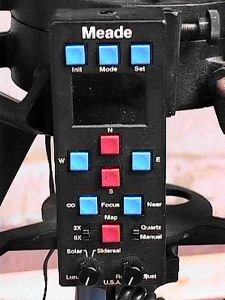
Meade's LX6/2120 10 inch F6.3 SCT
Introduction
Having previously reviewed the Meade LX200 (10 inch) and Celestron's Ultima
(9.25 inch), it was time to make my own choice for a replacement observatory
telescope. The main
 consideration
was cost with a secondary concern being the depreciation due to being left
in a cold and damp location. Obviously a second hand instrument has already
lost much of it's original value and will depreciate less. The LX6 was marketed
around 1989 and was the top of the range model. Some of it's features are
found on the current LX200 series. The LX6 was a luxury version of the standard
8 inch or 10 inch SCT, in the 10 inch version it came with the following
accessories as standard: consideration
was cost with a secondary concern being the depreciation due to being left
in a cold and damp location. Obviously a second hand instrument has already
lost much of it's original value and will depreciate less. The LX6 was marketed
around 1989 and was the top of the range model. Some of it's features are
found on the current LX200 series. The LX6 was a luxury version of the standard
8 inch or 10 inch SCT, in the 10 inch version it came with the following
accessories as standard:
Beefier Wedge (although not quite a Super Wedge), illuminated 9 x 60 finder
scope which includes polar alignment 'rings' - in my opinion it's not useable
for this purpose, hand controller, adjustable height tripod (with bubble
level and compass), 2 inch right angle adapter and 25mm eyepiece.
Accessories available for the LX6 series were digital circles with ra and
dec readout on the hand controller, focus motor and declination motor. Jim's
Mobile Inc (JMI) also produce these motors.
This telescope was offered for sale when the original owner 'upgraded' to
a superb Astro Physics refractor, the package included SGT-MAX digital setting
circles with a copy of 'The Sky' by Software Bisque and optional motors for
focus and declination.
 One of the main
features of the LX6 series was the microprocessor controlled electronic 'Command
Centre', however the only benefit when using one without the digital readout
is that the ra drive motor is reversed quickly when slewing East so the drive
resumes very quickly. The two slewing rates available are 'x2' and 'x8'
(including declination when the optional motor is fitted), with quartz crystal
control of drive speed when in sidereal mode and a variable speed control
marked with solar, sidereal and lunar tracking speeds. Other controls on
the Command Centre are a very useful led map light that's more than adequate
and a variable control for a wired illuminated reticle eyepiece. The telescope
is 12 volts dc powered and draws between 500mA and 800mA depending on whether
the various options are fitted, at this power level it is possible to run
the scope from quite a small gel cell or even from alkaline penlight cells.
The only other item worthy of note is the North - South switch that reverses
the drive for use in either
hemisphere. One of the main
features of the LX6 series was the microprocessor controlled electronic 'Command
Centre', however the only benefit when using one without the digital readout
is that the ra drive motor is reversed quickly when slewing East so the drive
resumes very quickly. The two slewing rates available are 'x2' and 'x8'
(including declination when the optional motor is fitted), with quartz crystal
control of drive speed when in sidereal mode and a variable speed control
marked with solar, sidereal and lunar tracking speeds. Other controls on
the Command Centre are a very useful led map light that's more than adequate
and a variable control for a wired illuminated reticle eyepiece. The telescope
is 12 volts dc powered and draws between 500mA and 800mA depending on whether
the various options are fitted, at this power level it is possible to run
the scope from quite a small gel cell or even from alkaline penlight cells.
The only other item worthy of note is the North - South switch that reverses
the drive for use in either
hemisphere.
Having already covered much of the common ground with SCT's in the other
two reviews, I'll try and mention the pro's and con's of the LX6 relative
to other telescopes and in particular the newer Meade and Celestron units.
Bad points
1. After several weeks of use, it has become apparent that despite Meade's
claim about the superb tracking accuracy of the quartz drive, the drive produces
some very irritating random tracking errors. These make ccd work tedious
although with the aid of dual axis drive correction, normal photographic
work should be straightforward.
2. The forks seem rather flexible and have quite a 'spring' when carrying
the very heavy tube assembly by one fork, also there is a rather unnerving
clunk as the tube's weight flex's one fork more than the other when viewing
in the East or West (there doesn't seem to be anything locking the tube to
the forks to prevent this). The current LX50 and LX200's have much stiffer
forks.
3. Despite Meade's claim that f6.3 optics aren't any worse on planetary detail
than f10 optics, this scope performed rather badly when compared to a low
cost 6 inch Newtonian when viewing Mars.
4. Allen keys are needed to bolt the fork assembly to the wedge (see Meade
LX200 review for photographs of the same mounting), it's very easy to forget
to take Allen keys when you travel or to loose one into grass. Hand wheel
bolts would have been a better choice as per the Celestron 9.25 inch unit.
5. In common with many fork mounted telescopes, there is no polar alignment
telescope. Accurate polar alignment is only possible by the drift method,
this can take an hour or more. By comparison, Vixen and Losmandy german
equatorial mounts can be fitted with very accurate polar alignment scopes
in their polar axis.
Good points
1. The illuminated 9 x 60 finder is the best view finder I've ever used,
why aren't more scopes supplied with such a useful accessory as standard?
2. The mounting bolts do actually line up with their holes, maybe this is
just a fluke as later scopes don't seem to line up!
3. There is no backlash in either ra or declination.
4. From a second user point of view the LX6 series come with many of the
features that are costly extras on modern scopes, at roughly a third of the
cost of the current equivalent it's a good second hand buy for those on a
limited budget.
Finally...
I've replaced the mounting for this telescope with a Losmandy G-11 German
equatorial mount. The difference in overall stability is amazing, although
it costs a great deal more for the G-11 compared to the Meade fork mount,
I feel the difference in cost to be well worth the extra expense.
Jump to top of page



|
